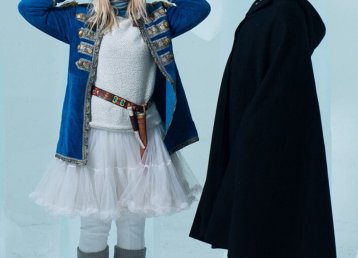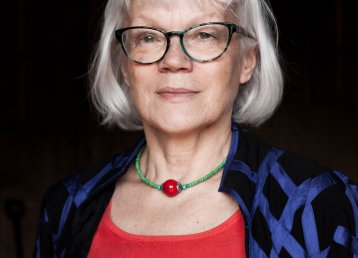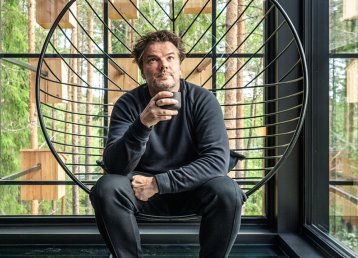A quiet sigh
Theodor Ringborg hangs up his phone, and perhaps I hear a quiet sigh. He has just spoken to a journalist wanting to know “when he will put his shovel in the ground [referring to Konsthall Tornedalen]”. It’s just another impatient reporter who wants to be the first one to write about the much-talked-about Konsthall Tornedalen being built.
— It’s difficult to make people understand that this kind of project takes time. It’s as if they think an art space can be built just like that. Creating a proper venue for art takes time, and sometimes it’s good that it takes a while. It gives you time to decide what needs there are that have to be fulfilled.
— At the same time it’s definitely exciting that there is so much interest. It just goes to show that the demand is there.
When Theodor Ringborg, director of the prominent gallery Bonniers Konsthall in Stockholm, handed in his resignation and took the job as director of Konsthall Tornedalen it caused headlines in the culture sections of the broadsheets, as well as in the local papers. Up until then, this art space in the Torne Valley only existed as a vision and an architect’s drawing.
— Yes, for sure, some eyebrows were raised when my wife and I decided to move to the Torne Valley with our children. But I was very very done with Stockholm.
— Today when I wake up and hit the button on the coffee maker in the kitchen at home, my view is of the Torne River and Finland. From our apartment in the city it was the window of the neighbouring building, where an old man would leave his tv on day and night.
— Also, and this must be noted, being part of the project Konsthall Tornedalen, helping it come to fruition, is irresistible to someone like me.
A long story
His phone rings again and this time Theodor speaks English, which is incidentally the language he feels most at home with, as he spent a large part of his youth in Washington in the US. The person on the other end is calling from the University of Florida, and suddenly Picasso’s name is mentioned in the conversation, causing an immediate reaction. Theodor hangs up and laughs.
— Well I’ll be damned. It’s on its way. Picasso is coming to Vietsaniemi!
— How’s that for a story?
— Well, it’s a long story. But it’s a good one.
"The reality is that Northern Sweden, more than half the country, is more or less left outside the great world of art"
— Theodor Ringborg
Apparently, Pablo Picasso made a model in 1961 for a sculpture that was to be built in Kiruna. The whole thing was meant to be payed for by the Kiruna municipality and the mining company LKAB. The sculpture would have been 33,5 metres high and placed outside a museum/centre of Sami art and culture that the municipality was also planning. (This museum plan hasn’t been completely verified; it figures in some archives.) Unfortunately, none of this actually happened. Kiruna didn’t get a sculpture, and no museum was ever built. And the model of the sculpture ended up at the University of Florida.
— When I found out about the sculpture, and then about the model, I wanted it here, of course. But since there is no climate-controlled facility for art in the entire region up here in the north, it’s impossible. The reality is that Northern Sweden, more than half the country, is more or less left outside the great world of art.
— What we’ve done instead is a 3D scan, and they are printing it for us there, at the University of Florida. This means a Picasso model is, after all, on its way to Vietsaniemi.
Images of the place
Theodor talks about this several times during our conversation: how unfair it is that the north of Sweden doesn’t have a proper art space. That is, an art space with sufficient security and climate control where valuable and sensitive works of art can be loaned and exhibited according to museum standards. He doesn’t use the word colonialisation, but it’s a perfect picture of the effect of it. In the northernmost part of Sweden there’s no way of experiencing the famous works of artists who created the image of the place, in one way or another. You can’t loan pieces from the large institutions in the south of Sweden and show them in the north. If you want to see Nils Nilsson Skum’s artworks in their collections, you have to go to the National Museum in Stockholm, and people who want to see works made by “the artistic explorer of Northern Sweden”, Helmer Osslund, also have to head south. There are some pieces by these artists in the north to be seen, but loans from museums world wide aren’t possible.
— Imagine Nils Nilsson Skum: he was nine years old when he was given his first pencil, from his father I think. His first drawings were made on the backs of empty sugarloaf packets.
— Nils Nilsson Skum went from that to participating in the World Exhibition in Paris 1937, where his art became widely known. It’s said that the Swedish national railway, SJ, even built a station house by his home, in Sjisjka on the Iron Ore Line.
— It was an extraordinary journey! But we’re not able to appreciate his art collected by institutions in the south. At least not here, where it was once created. Does that seem fair?
Explore the north
In this film you get to follow Sarah and Tobias as they explore the north of Sweden. Way above the arctic circle they visit husky kennels, go biking in the woods, paddling on winding water ways and enjoying the Arctic cuisine.
Juggling chainsaws
This newcomer to the area, Theodor, makes an exciting impression. He has a master’s degree from the University of Arts, Crafts and Design – Konstfack – in Stockholm and a PhD from Goldsmiths in London with a thesis on ‘Visual Cultures’. He went on to work as a curator at the prestigious institution Bonniers Konsthall and then became its artistic director before heading off to Konsthall Tornedalen: a project that, so far, consists of a vision and an architect’s drawing. But Theodor’s story also includes juggling at Circus Scott as well as knowing why you replace trucks on a skateboard. He can also walk a tightrope and there are pictures of him juggling burning chainsaws. He says:
— My wife is from Kangos, so we’ve spent a lot of time in the Torne Valley. What struck me early on was the massive commitment you’ll find in the villages. The social movement. It’s easy to forget that culture is a part of what makes a village stick together.
"There's always been a rich cultural life in every town but part of it was lost due to the urbanisation"
— Theodor Ringborg
In the 1960s, Swedes literally packed their suitcases and moved to the city. Rural people would even get paid to do so. A so-called ‘relocation allowance’.
— That’s something we have to understand, and discuss. There’s always been a rich cultural life in every town. But part of it was lost due to the urbanisation in the 1960s and the 1970s, when so many left these villages.
— I really want to help change this. Letting people who live here, but also those who visit this place, have access to our cultural life and heritage.
Up and running
An hour or so later we visit the cinema in Vietsaniemi. This place was built during raging war, in 1944–45, later it burnt down, and was rebuilt. The last film shown was in 1974 – that is, until Theodor got access to the cinema. A week or so ago, Jenny Perlin’s acclaimed film Bunker was screened here and more than 50 people came to watch it. The film features people waiting for Armageddon who have decided to live in a bunker, or a nuclear silo.
— I must admit it isn’t the easiest film to watch. But I’m happy so many found their way here. When I worked for Bonniers we flew in a world-famous theorist for a lecture. Three people came.
Before that, in the middle of the darkest time of the year, two more films were shown. One of them, Flooded McDonald’s, was shown on a large screen at the spot where the art space will be built, below Arthotel. The other one, Nummer acht, everything is going to be alright, could be seen at the village cinema.
— To work as a director of an art space, having a physical space is optional. What you do need is art. I want to get the business up and running, even if we don’t have the building yet.
An Arctic Louisiana
But let’s take a look at the project Konsthall Tornedalen. It doesn’t all begin with Theodor and his family’s wish to move north. It begins in 2009, with another strong character, Gunhild Stensmyr, resident of Skäret in Skåne, homesick for the Torne Valley. Gunhild, like so many before her, moved south in the 1960s. She studied to become an art historian, and then worked as a director at various art galleries. In 2009 she returned to her home village for a visit and felt something inside of her change. She bought a house and renovated it. Then she bought another one, and then she bought even more properties. Gunhild renovated the houses with love and filled them with art and design, then started to rent them out. But what was it about these houses? People in the business asked what her unique selling point was.
— I pondered that for a while. There was Icehotel, then there was Treehotel and I had another one: Arthotel!
It turned out that what she had created was a unique hotel, a northern Albergo Diffuso, for people interested in art and design.
— As I stood there, looking across the Torne River to the Finnish side, it was impossible not to envision Konsthall Tornedalen – our very own Arctic Louisiana.
— Arthotel has been an exciting project, but the art space was always the big vision. We need art in our lives to feel good. Even if we live in the middle of nature, says Gunhild.
Arthotel Tornedalen
With art and a genuine countryside feel like stepping stones, Gunhild Stensmyr has created a unique yet holistic experience that holds both good food and great activities. Here is an insight into what to expect as you enter beautiful Arthotel Tornedalen.
Weather reports
Theodor Ringborg paces the Vietsaniemi cinema when his phone rings and he says he needs to take the call. It’s the artist duo Johdet Pirak, invited to the art space/Arthotel to work with a global art project: the World Weather Network. The project is about creating artistic weather reports, where the art space/Arthotel is one of 28 weather stations participating. Other participants range from design destinations such as Enoura Observatory in Japan, Fogo Island Arts in Canada, Bundanon in Australia and Te Tuhi in Auckland, New Zealand to exciting projects such as Sophia Point in Guyana, 32°East in Uganda, Nothing Gets Organised in Johannesburg and Dhaka Art Summit in Bangladesh, to quickly mention but a few nodes in this world-encompassing network. But they are all projects, places and institutions that provide world-class art projects and exhibitions. Theodor puts his phone away and apparently Johdet Pirak have car-related problems. They will arrive a day late, but Theodor says it doesn’t matter as the weather in the Torne Valley is too good anyway today. Nothing dramatic to report, really.
A certain exasperation
But what was the deal with Picasso and Kiruna? What really happened to that project? Theodor says he doesn’t really know, or rather that he’s not entirely sure. He’s done some research, but without finding a good, or definitive, answer to why it was cancelled. The sculpture was planned for the area now featuring Högalidsskolan, a school not far from Camp Ripan. Perhaps the need for a school was greater? You can sense a certain exasperation in the correspondence between entrepreneurs, artists, architects and the concrete supplier meant to cast the sculpture on the one hand, and the municipality and LKAB on the other. Replies arrive late, and increasingly frustrating questions are made on what concrete to use, and concerns about payment are raised.
"Armed miners from LKAB patrolled outside the town hall, acting as voluntary guards"
There is one letter from LKAB’s archives where you can read that the undersigned, J.M. Hansson, spoke to both architect Wiksjö and artist Nessjar on July 20, 1965. The two latter were “naturally interested in what was going to happen with the sculpture”. Hansson further states in his letter that engineer Nilsson in discussions had confirmed that it was difficult to “give a quote based on the drawings at hand” and also expressed that the company Naturbetong “on several occasions” had had troubles with “prices set based on drawings”.
Kiruna’s fascination with Picasso back then went beyond the cancelled idea of a sculpture. The town hall – commonly known as ‘the Igloo’ and said to be a living room for Kiruna’s inhabitants – was the setting of a Picasso exhibition arranged in 1965, featuring no fewer than 100 of the artist’s works. Armed miners from LKAB patrolled outside the town hall, acting as voluntary guards to protect them.
Something we’ve earned
Theodor says that a Picasso statue in Kiruna “certainly would have been something truly special”, but he again reverts to the fact that what’s missing is a proper art space, to showcase what’s been created here. His voice reflects how surprising he finds it that such a large part of the country is denied the possibility to see not just these great works of art, but their own artists’ works as well.
— The cultural life here has always been solid. We’ve mentioned artists such as Osslund and Nilsson Skum, but there’s also the exciting photographer Mia Green in Haparanda, painter Anna Boberg who captured the northern lights, Finnish Reidar Särestöniemi who took on the landscapes around Kittilä – we need to be able to share them. Right here.
— The art space we’re going to build, designed by the Finnish firm of architects OOPEA, has exactly what’s needed: sufficient security and climate control. The fact is that if the art space had already been built, there would have been no need for that 3D-scanned model from the University of Florida. We could have flown in the original model to the exhibition.
— Others can say what they like. This is, in a way, something we’ve earned.
































